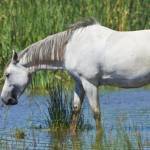Peat Moss as a Horse Feed Ingredient

Reed sedge peat moss is a natural product that is composed of partially decomposed moss and other plant vegetation that accumulates in damp areas called bogs, mires, moors, or peats. Its name is derived from some of the plant components, including reeds, sedges, and grasses, that have grown in the damp areas where moss decays. The product is mined out of the bogs and packaged for use.
Peat can vary considerably. In natural bogs, the peat forms many layers, each with differing characteristics. Peat moss from different regions of a bog can also be variable based on the vegetation growing in that area. Reed-sedge peat moss that is being used by feed manufacturers should be derived from a consistent layer.
Reed-sedge peat is only occasionally used in horse feed, although some manufacturers put it in almost all of their products. “One horse feed manufacturer says they use reed-sedge peat as a minor source of trace minerals, for absorbing excess moisture, and as a binder for some toxins,” explained Kathleen Crandell, Ph.D. , a nutritionist with Kentucky Equine Research (KER). “It is more commonly included in livestock feeds, as all of the available research seems to have been performed in livestock, namely pigs. I am not aware of any research involving reed-sedge peat moss and horses.”
Sometimes peat shows up on the label in livestock feed because it is being used as a pellet binder to make the pellet more durable and less likely to crumble.
Generally speaking, reed-sedge peat moss has little nutritive value for horses because it is tremendously high in lignin and low in protein, Crandell said.
Certain compounds found in peat may make it useful in animal feeds, though. Fulvic and humic acids are thought to bind to heavy metals and bacterial toxins making them unavailable for absorption by the intestinal tract. Peat preparations can also provide protection to the sensitive mucosa of the digestive tract in young animals to prevent diarrheal diseases, which is why it is commonly used in piglets. Peat can contain water-soluble components that may have a stimulatory effect on smooth muscle such as found in the digestive tract.
On the other hand, according to Crandell, peat may potentially contain dangerous mycobacteria that contaminate the product after it has been mined because of high humidity. “When it is used as a feed additive, I assume care has been taken to avoid contaminated peat because of adverse health effects in animals,” she said.
Do you ever look at the ingredients in your horse’s feed? Do you ever wonder if you’re feeding your horse the best diet possible. If you have a question about feeds or feeding, the nutrition advisors at KER would love to hear from you. Go now!








